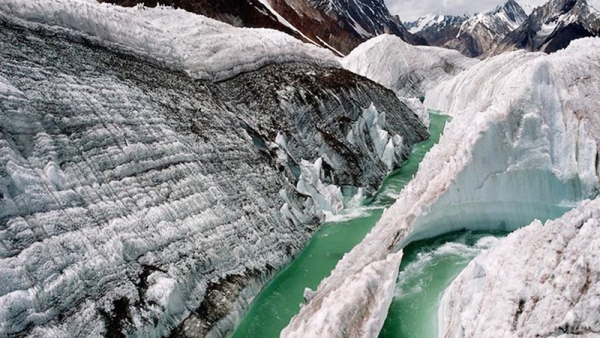Climate change melting 5,000 glaciers rapidly, drastic impact expected

Around 5,000 glaciers in northern areas of Chitral district and Gilgit-Baltistan region are melting at a much faster rate due to increase in average temperatures in the mountainous valleys.
“Presently, glacial melting is among major global warming-induced risk Pakistan is grappled with. Other risks include sea-level rise, floods, higher than average temperature, a higher frequency of droughts and expanding desertification," Deputy Director Ministry of Climate Change Mohammad Saleem Shaikh told APP here Tuesday.
During summer months, he said, increased or above normal flows in glacial streams, which all eventually feed the 3,500 kilometers-long Indus River, clearly indicate that the country's glaciers are melting rapidly.
The mountain streams now flow even in winter, which was never observed couple of years ago as revealed by the residents particularly Hunza, Ghizer, Gupis, Skardu, Gulmit and Bagrot valleys of the Gilgit-Baltistan in the country's north, reflecting the gravity of the global warming issue, he said.
"Temperatures in most of the mountainous valleys never used to go beyond 30 degree Celsius during summer but now it surpasses 40 degree Celsius at times."
This rise in temperature was causing expansion of rainy weather on one hand and squeezing the snowfall period on the other. The reduced snowfall period makes it difficult for the snow to take the shape of glaciers," Mohammad Saleem said.
Increase in frequency and intensity in rainfall instead of snowfall in these mountains triggers flash floods, which results in large-scale damages in the areas. The official, who is also spokesman of the ministry, said besides rising earth temperatures, high paced urbanization of the mountain valleys and increased vehicular traffic have accelerated the melting process of the glaciers.
However, Pakistani scientists have already said that glaciers in Pakistan's Karakoram mountain range in the Upper Indus Basin areas were stable and some were even building up. But research-based strong evidences show that a good number of glaciers are now melting fast due to rising tempratures.
This is alarming that melting process continues in winter also due to which we find exceptional flow in streams and rivers. This is causing flooding in these valleys, posing risks to lives and livelihoods of the people besides damaging the infrastructure in these areas.
Recent findings of 10 weather monitoring stations installed by the Pakistan Meteorological Department also concluded that glaciers in ablation zone [which refers to the low-altitude area of a glacier] is receding faster and snowline is marching upward. This means shrinking in the glacier area. "This means that the ablation zones are increasing and accumulation zones of the glaciers reducing."
It is because at the lower elevation up to 2,500 meters the heat penetration is increasing, which is causing the glaciers shrink at such elevation levels. For instance, one weather monitoring station installed at the Hinarchi glacier in Bagrot valley of Gilgit district, has showed that the glacier has retreated 800 metres in the 32 years between 1977 and 2009. It retreated another 300 metres between 2009 and 2014.
Likewise, the Baulter glacier which had retreated 1,500 metres, shrank another 400 metres by 2014. The future of the Barpu glacier looks bleak as it has shrunk 640 metres since 1977.
These weather monitoring stations of the Pakistan Meteorological Department also showed that over one degree Celsius rise in temperature, which caused the formation of glacial lakes and the phenomenon of GLOF - glacial lakes outburst floods - occasionally high river flows, land slips and slides.
According to the Pakistan Meteorological Department (PMD), there were some 2,400 potentially hazardous glacial lakes in the country's remotest mountain valleys in 2010, a number that has now increased to over 3,000. On the other hand, some glaciologists say that now all Karakorum glaciers were melting. They estimate that 58 percent glaciers in the area were gaining mass and 42 percent were shredding. But such observations of the glaciologists are based on satellite observations and not field studies.
The surging glacial melt during summer months, particularly during monsoon season (June-September) would often lead to river flooding downstream. On the heels of reports of rapid glacier melting in the country's north, warnings have been already sounded by water experts that the country would most likely confront an acute water shortage, because there would no longer be any water reserves in the form of glaciers.
This poses stark risk to the sustainability of agriculture sector, which is mainstay of the country's economy. These negative impacts of global warming on the country's glaciers can be mitigated with adaptation measures, such as water conservation at domestic, industrial in general and agriculture in particularly. Because, agriculture consumes nearly 96 percent of the total water available in any form.
Water reservoirs of varying sizes would compliment the water conservation measures that should be backed by nation-wide public awareness for wise use of the water resources in every possible manner and wastage of the natural resource must be made a punishable crime.

Facebook comments